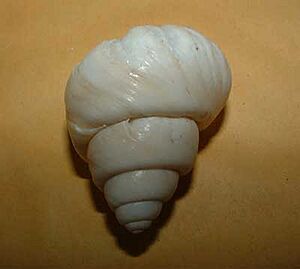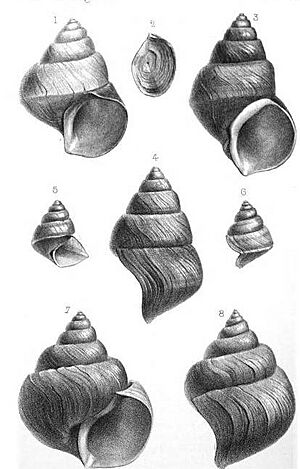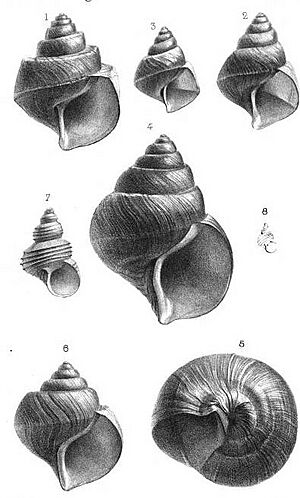Neothauma facts for kids
Quick facts for kids Neothauma |
|
|---|---|
 |
|
| shell of Neothauma tanganyicense | |
| Conservation status | |
| Scientific classification |
|
| Kingdom: | Animalia |
| Phylum: | Mollusca |
| Class: | Gastropoda |
| Subclass: | Caenogastropoda |
| Order: | Architaenioglossa |
| Superfamily: | Viviparoidea |
| Family: | Viviparidae |
| Genus: | Neothauma E. A. Smith, 1880 |
| Type species | |
| Neothauma tanganyicense E. A. Smith, 1880 |
|
| Synonyms | |
|
Viviparus (Neothauma) E. A. Smith, 1880 |
|
Neothauma is a type of freshwater snail. These snails live in water and have a special part called a gill to help them breathe. They also have an operculum, which is like a little door that closes their shell opening. Neothauma snails belong to a group of molluscs called gastropods.
Contents
Types of Neothauma Snails
There are a few different types of Neothauma snails. The most well-known one is Neothauma tanganyicense. Some other types include:
- Neothauma jouberti
- † Neothauma jupadwongaensis (The dagger † means this species is only known from fossils.)
Over time, some snails that were once called Neothauma have been moved to other groups. This happens as scientists learn more about them. For example, Neothauma ecclesi is now known as Bellamya ecclesi.
Where Neothauma Snails Live
These freshwater snails are only found in Lake Tanganyika. This lake is one of the largest and deepest lakes in the world. It is located in Africa. Neothauma snails are the biggest snails living in Lake Tanganyika.
You can find them in all four countries that border the lake:
Scientists have also found fossil shells of Neothauma in other places. These include Lake Edward and the Lake Albert basin. This shows that these snails once lived in a wider area. The first Neothauma snail found was on the east shore of Lake Tanganyika, near a place called Ujiji.
History of Discovery
The Neothauma group of snails used to include many different species. However, as scientists studied them more closely, they realized that most of these species actually belonged to other snail groups. This means that the Neothauma group is now smaller than it once was.
What Neothauma Snails Look Like
The shell of a Neothauma snail can be quite large. It can be about 46 millimeters (about 1.8 inches) wide. The height of the shell can reach about 60 millimeters (about 2.4 inches). This makes them stand out in their lake home.
How Neothauma Snails Live
Neothauma snails live in the deeper parts of Lake Tanganyika. They can be found at depths of up to 65 meters (about 213 feet).
Scientists have different ideas about what these snails eat. Some believe they eat detritus, which are tiny bits of decaying plants and animals. Others think they might hunt for small creatures living in the mud. There is also an idea that they filter small food particles from the water while they are buried in the sediment.
The empty shells of dead Neothauma tanganyicense snails often cover large areas of the lakebed. These shell "carpets" become homes for many other animals. For example, a type of cichlid fish called "shell dwellers" live inside these empty shells. Freshwater crabs from the group Platythelphusa also use them.
Young Neothauma snails often live hidden in the mud or sand. This helps them stay safe from animals that might want to eat them.




